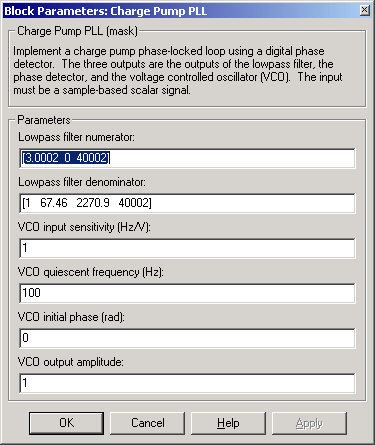| Communications Blockset |
  |
Charge Pump PLL
Implement a charge pump phase-locked loop using a digital phase detector
Library
Synchronization
Description

The Charge Pump PLL (phase-locked loop) block automatically adjusts the phase of a locally generated signal to match the phase of an input signal. It is suitable for use with digital signals.
This PLL has these three components:
- A sequential logic phase detector, also called a digital phase detector or a phase/frequency detector.
- A filter. You specify the filter's transfer function using the Lowpass filter numerator and Lowpass filter denominator mask parameters. Each is a vector that gives the respective polynomial's coefficients in order of descending powers of s.
- To design a filter, you can use functions such as
butter, cheby1, and cheby2 in the Signal Processing Toolbox. The default filter is a Chebyshev type II filter whose transfer function arises from the command below.
[num, den] = cheby2(3,40,100,'s')
- A voltage-controlled oscillator (VCO). You specify characteristics of the VCO using the VCO input sensitivity, VCO quiescent frequency, VCO initial phase, and VCO output amplitude parameters.
The input signal represents the received signal. The input must be a sample-based scalar signal. The three output ports produce:
- The output of the filter
- The output of the phase detector
- The output of the VCO
A sequential logic phase detector operates on the zero crossings of the signal waveform. The equilibrium point of the phase difference between the input signal and the VCO signal equals  . The sequential logic detector can compensate for any frequency difference that might exist between a VCO and an incoming signal frequency. Hence, the sequential logic phase detector acts as a frequency detector.
. The sequential logic detector can compensate for any frequency difference that might exist between a VCO and an incoming signal frequency. Hence, the sequential logic phase detector acts as a frequency detector.
Dialog Box

- Lowpass filter numerator
- The numerator of the lowpass filter's transfer function, represented as a vector that lists the coefficients in order of descending powers of s.
- Lowpass filter denominator
- The denominator of the lowpass filter's transfer function, represented as a vector that lists the coefficients in order of descending powers of s.
- VCO input sensitivity (Hz/V)
- This value scales the input to the VCO and, consequently, the shift from the VCO quiescent frequency value. The units of VCO input sensitivity are Hertz per volt.
- VCO quiescent frequency (Hz)
- The frequency of the VCO signal when the voltage applied to it is zero. This should match the frequency of the input signal.
- VCO initial phase (rad)
- The initial phase of the VCO signal.
- VCO output amplitude
- The amplitude of the VCO signal.
See Also
Phase-Locked Loop
References
For more information about digital phase-locked loops, see the works listed in Selected Bibliography for Synchronization in Using the Communications Blockset.
 | BPSK Modulator Baseband | | Complex Phase Difference |  |





 . The sequential logic detector can compensate for any frequency difference that might exist between a VCO and an incoming signal frequency. Hence, the sequential logic phase detector acts as a frequency detector.
. The sequential logic detector can compensate for any frequency difference that might exist between a VCO and an incoming signal frequency. Hence, the sequential logic phase detector acts as a frequency detector.
